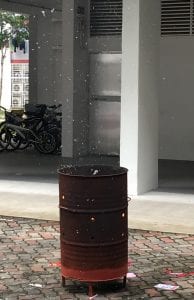Previously, I mentioned how the Hungry Ghost Festival has an impact on our air quality and general hygiene. In this post, I will discuss the measures that have been or can be taken to mitigate these impacts.
A netizen’s suggestion to move with the times.
Comment extracted from here
Joss paper burning
In some residential areas, the burning bins provided have large holes that cause ash to be blown away easily.
The open-air design of these bins means pollutants are easily carried away by the wind.
Image courtesy of Imgur
In 2014, the government introduced eco-friendly joss paper burning bins with an improved closed top design, which prevents ash from flying out (The Straits Times, 2015). Air vents in the bin allow better airflow to facilitate complete combustions, reducing the amount of smoke and pollutants emitted (Science Learning Hub, 2009).
Left: Improved closed-top bin, Right: Old open-top bin
Currently, all three types of bins are still in use, but I think the government should replace all open-top bins with the improved closed-top ones given its effectiveness in reducing the spread of ash and smoke. Although these improved bins are more expensive, they are definitely a worthwhile investment for better air and health.
Joss Sticks
With regards to joss sticks, more research can be done to explore alternative methods to manufacture incense such that the byproducts from burning it are less harmful. For example, a study found that the use of oyster shells in producing incense can reduce particulate matter emission (Yang C.R. et al, 2012). The calcium carbonate content in oyster shells is resistant to burning, hence facilitating the effective burning of the other components in the incense (Yang C.R. et al, 2012).
Food offerings
After my last post on how food offerings can attract birds and rats, my friend Wan Teng shared on how her grandmother started to bring food offerings home in recent years to not waste food. This unconventional practice (Clarke, 2018) shows that there is no hard and fast rule when it comes to traditional rituals as mindsets and practices can change with time.
While it may be difficult to convince people to consume their offerings, a regulation can be put in place to mandate that individuals remove these food offerings once they are done with the rituals. This would retain the core of the rituals while solving the problems of hygiene. I’m sure the spirits will understand – because who wants to share their food with birds?
These are my thoughts on how we can mitigate the environmental problems from the Hungry Ghost Festival. If you have other suggestions, do share them with me in the comments section below.
With that, we have come to the end of the Hungry Ghost Festival series. While the Hungry Ghost Festival is more sombre than celebratory, I decided to discuss it as its impacts are very relatable to Singaporeans. Next week, I will move on to happy celebrations proper!
References:
The Straits Times (Sep 6, 2015). Eco incense paper burners prove popular
Retrieved from: https://www.straitstimes.com/singapore/eco-incense-paper-burners-prove-popular
Science Learning Hub (Nov 19, 2009). What is smoke?
Retrieved from: https://www.sciencelearn.org.nz/resources/748-what-is-smoke
Yang C.R., Ko T.H., Lin Y.C. Lee S.Z., Chang Y.F., Hsueh H.T. (Jul 28, 2012). Oyster shell reduces PAHs and particulate matter from incense burning
Retrieved from: https://link-springer-com.libproxy1.nus.edu.sg/article/10.1007%2Fs10311-012-0374-2
Clarke, B. (Aug 3, 2018). A guide to the Hungry Ghost Festival: Don’t let the spirits catch you off guard this season
Retrieved from: https://thehoneycombers.com/hong-kong/hungry-ghost-festival-hong-kong-culture/







